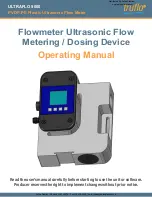
12
EXAMPLES
1. Unsigned 32-bit Values
If you read unsigned Voltage V1 of 69,000V from registers 13952-13953, then the register readings will
be as follows:
(13952) = 3464
(13953) = 1
The 32-bit value is (1 x 65536 + 3464) = 69000V.
2. Signed 32-bit Values
If you read signed kW of -789kW from registers 14336-14337, then the register readings will be:
(14336) = 64747 (unsigned)
(14337) = 65535 (unsigned) or -1(signed value).
To take the high order register as a signed value, compare it with 32767. If the value is less or equal to
32767, use it as is. If it is greater than 32767, then this is a negative number in a two's complement
code (like in our example) - just subtract it from 65536 to get the original negative value.
The 32-bit reading is (-1 x 65536 + 64747) = -789kW.
Fractional 32-bit data is transmitted using a decimal pre-multiplier to pass fractional
numbers in an integer format. Fractional numbers are pre-multiplied by 10 to the power N,
where N is the number of digits in the fractional part. For example, the frequency reading of
50.01 Hz is transmitted as 5001, having been pre-multiplied by 100.
Whenever a data register contains a fractional number, the register measurement unit is
given with a multiplier
×
0.1,
×
0.01 or
×
0.001, showing the weight of the least significant
decimal digit. To get an actual fractional number with specified precision, multiply the
register value by the given multiplier. To write a fractional number into the register, divide
the number by the given multiplier.
2.7.3 32-bit Floating Point Format
32-bit analog registers, energy registers and binary counters, and 32-bit Min/Max registers
(see Sections 3.3-3.5) can be read in IEEE single precision floating point format in two
adjacent 16-bit Modbus registers, the low order register first.
The low-order register always starts at an even Modbus address.
2.7.4 32-bit Modulo-10000 Format
Energy counters 287-294 and 301-302 are read in two contiguous 16-bit registers in a
modulo-10000 format. The first (low order) register contains the value mod 10000, and the
second (high order) register contains the value/10000. To get the true energy reading, the
high order register value should be multiplied by 10,000 and added to the low order
register.
2.8 User Assignable Registers
The PM130 provides 120 user assignable registers in the address range of 0 to 119. You can
re-map any register available in the meter to any assignable register so that Modbus
registers that reside at different locations may be simply accessed using a single request by
re-mapping them to adjacent addresses. Refer to Configuring Modbus in the PM130 PLUS
Installation and Operation Manual for information on how to configure the assignable
registers via PAS.
The actual addresses of the assignable registers, which are accessed via addresses 0
through 119, are specified in the register map (registers 120 through 239), where register
120 contains the actual address of the register accessed via register 0, register 121
contains the actual address of the register accessed via register 1, and so on. The
assignable registers and the map registers themselves may not be re-mapped.
Initially these registers are reserved and none of them points to an actual register address.
To build your own register map, write to map registers 120 to 239 the actual addresses you
Provided
by
Northeast
Power
Systems,
Inc.
www.nepsi.com













































